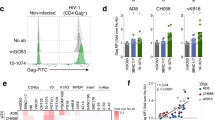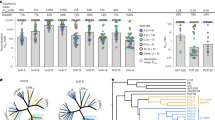Abstract
BINDING of glycoprotein gp120 to the T cell-surface receptor CD4 is a crucial step in CD4-dependent infection of a target cell by the human immunodeficiency virus (HIV)1–5. Blocking some or all gp120 molecules on the viral surface should therefore inhibit infection. Consequently, competitive receptor inhibitors, such as soluble synthetic CD4 (sCD4), synthetic CD4 peptides and immunoglobulins, have been investigated in vitro6–17 and in vivol8–20 but little is known about the molecular mechanisms of these inhibitors. We have now quantitatively examined blocking by soluble CD4 in the hope of gaining insight into the complex process of viral binding, adsorption and penetration. At low sCD4 concentrations, the inhibition in three HIV strains is proportional to the binding of gp120. The biological association constant (gp120-sCD4 Kassoc) for HIV-2NIHZ is (8.5±0.5)×107M−1, whereas Kassoc for HIV-1HXB3 (1.4±0.2) and HIV-1MN (1.7±0.1)×109 M−1 are 15–20-fold larger. For all three viral strains, the biological Kassoc from infectivity assays is comparable to the chemical Kassoc. The inhibitory action of sCD4 at high concentrations, however, is not fully explained by simple proportionality with the binding to gp120. Positive synergy in blocking of infection occurs after about half the viral gp120s molecules are occupied, and is identical for all three viral strains, despite the large differences in Kassoc. Our method of measuring the viral-cell receptor Kassoc directly from infectivity assays is applicable to immunoglobulins, to other viruses and to assays using primary or transformed cell lines.
This is a preview of subscription content, access via your institution
Access options
Subscribe to this journal
Receive 51 print issues and online access
$199.00 per year
only $3.90 per issue
Buy this article
- Purchase on Springer Link
- Instant access to full article PDF
Prices may be subject to local taxes which are calculated during checkout
Similar content being viewed by others
References
Dalgleish, A. G. et al. Nature 312, 763–767 (1984).
Klatzmann, D. et al. Nature 312, 767–768 (1984).
McDougal, J. S. et al. Science 231, 382–385 (1986).
Kowalski, M. et al. Science 237, 1351–1355 (1987).
Bedinger, P. et al. Nature 334, 162–165 (1988).
Lasky, L. A. et al. Cell 50, 975–985 (1987).
Smith, D. H. et al. Science 238, 1704–1707 (1987).
Fisher, R. A. et al. Nature 331, 76–78 (1988).
Hussey, R. E. et al. Nature 331, 78–81 (1988).
Deen, K. C. et al. Nature 331, 82–84 (1988).
Traunecker, A., Lüke, W. & Karjalainen, K. Nature 331, 84–86 (1988).
Clapham, P. R. et al. Nature 337, 368–370 (1989).
Capon, D. J. et al. Nature 337, 525–531 (1989).
Traunecker, A., Schneider, J., Kiefer, H. & Karjalainen, K. Nature 339, 68–70 (1989).
Nara, P. L., Hwang, K. M., Rausch, D. M., Lifson, J. D. & Eiden, L. E. Proc. natn. Acad. Sci. U.S.A. 86, 7139–7143 (1989).
Sun, N.-C. et al. J. Virology 63, 3579–3585 (1989).
Byrn, R. A. et al. J. Virology 63, 4370–4375 (1989).
Watanabe, M. et al. Nature 337, 267–270 (1989).
Schooley, R. T. et al. Ann. intern. Med. 112, 247–253 (1990).
Kahn, J. O. et al. Ann. intern. Med. 112, 254–261 (1990).
Layne, S. P., Spouge, J. L. & Dembo, M. Proc. natn. Acad. Sci. U.S.A. 86, 4644–4648 (1989).
Spouge, J. L., Layne, S. P. & Dembo, M. Bull. math. Biol. 51, 715–730 (1989).
Nara, P. L. et al. AIDS Res. hum. Retroviruses 3, 283–302 (1987).
Nara, P. L. & Fischinger, P. J. Nature 332, 469–470 (1988).
Sweet, R. et al. Fifth Int. Conf. AIDS Abstr. W.C.O. 12 (1989).
Myers, G. et al. Human Retroviruses and AIDS Section III, 9–12 (Los Alamos National Laboratory, New Mexico, 1990).
Nara, P. L. in Vaccines 89 (eds Lerner, R. A., Ginsberg, H., Chanock, R. M. & Brown, F.) 137–144 (Cold Spring Harbor Laboratory, New York, 1989).
Icenogle, J. et al. Virology 127, 412–425 (1983).
Emini, E. A., Ostapchuk, P. & Wimmer, E. J. Virology 48, 547–550 (1983).
Taylor, H. P., Armstrong, S. J. & Dimmock, N. J. Virology 159, 288–298 (1987).
Goudsmit, J. et al. Proc. UCLA Symposia (in the press).
Looney, D. J. et al. Science 241, 357–359 (1988).
Saag, M. S. et al. Nature 334, 440–444 (1989).
Cordonnier, A., Montagnier, L. & Emerman, M. Nature 340, 571–574 (1989).
Zwart, G. et al. Lancet l, 474 (1990).
Özel, M., Pauli, G. & Gelderblom, H. R. Arch. Virology 100, 255–266 (1988).
Earl, P. L., Doms, R. W. & Moss, B. Proc. natn. Acad. Sci. U.S.A. 87, 648–652 (1990).
Pyle, S. W. et al. AIDS Res. Hum. Retroviruses 3, 387–400 (1987).
Kendall, M. & Stuart, A. The Advanced Theory of Statistics Vol. 2 (Griffin, London, 1979).
Efron, B. & Tibshirani, R. Stat. Sci. 1, 54–77 (1986).
Moore, J. P. AIDS 4, 297–305 (1990).
Author information
Authors and Affiliations
Rights and permissions
About this article
Cite this article
Layne, S., Merges, M., Dembo, M. et al. HIV requires multiple gp120 molecules for CD4-mediated infection. Nature 346, 277–279 (1990). https://doi.org/10.1038/346277a0
Received:
Accepted:
Issue Date:
DOI: https://doi.org/10.1038/346277a0
This article is cited by
-
Development of antigen capture ELISA for the quantification of EIAV p26 protein
Applied Microbiology and Biotechnology (2014)
-
The trinity of the cortical actin in the initiation of HIV-1 infection
Retrovirology (2012)
-
A time delay model about AIDS-related cancer: equilibria, cycles and chaotic behavior
Ricerche di Matematica (2007)
-
Inhibiting sexual transmission of HIV-1 infection
Nature Reviews Microbiology (2003)
-
The HIV gp120-CD4 interaction: A target for pharmacological or immunological intervention?
Perspectives in Drug Discovery and Design (1993)
Comments
By submitting a comment you agree to abide by our Terms and Community Guidelines. If you find something abusive or that does not comply with our terms or guidelines please flag it as inappropriate.



